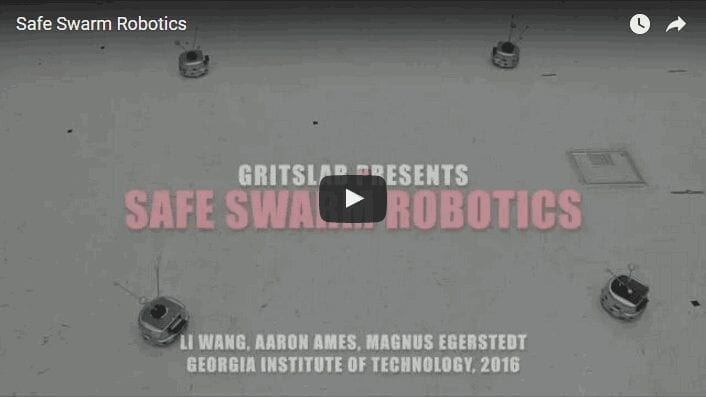
When roboticists create behaviors for teams of robots, they first build algorithms that focus on the intended task. Then they wrap safety behaviors around those primary algorithms to keep the machines from running into each other. Each robot is essentially given an invisible bubble that other robots must stay away from. As long as nothing touches the bubble, the robots move around without any issues. But that’s where the problems begin.
“When you have too many robots together, they get so focused on not colliding with each other that they eventually just stop moving,” said Georgia Tech roboticist Magnus Egerstedt, director of Georgia Tech’s Institute of Robotics and Intelligent Machines. “Their safety behaviors take over and the robots freeze. It’s impossible for them to go anywhere because any movement would cause their bubbles to pop.”
Egerstedt has created a solution. His team’s new algorithms allow any number of robots to move within inches of each other, without colliding, to complete their task — swapping locations on his lab floor. They are the first researchers to create such minimally invasive safety algorithms.
In technical speak, the bots are using a set of safe states and barrier certificates to ensure each stays in its own safe set throughout the entire maneuver.
“In everyday speak, we’ve shrunk the size of each robot’s bubble to make it as small as possible,” said Egerstedt. “Our system allows the robots to make the minimum amount of changes to their original behaviors in order to accomplish the task and not smack into each other.”
In a demo with four robots, the lab’s machines approach from four different areas, meet in the middle, circle counterclockwise within inches of each other, then fan out into opposite directions. In another demonstration, eight robots perform the same task, this time circling clockwise before dispersing. Instead of keeping their distance and taking the long way around their neighbors, the robots move very independently wherever they wish.
Avoiding collisions isn’t anything new in robotics. And Google’s self-driving cars are almost crash-free.
“But we haven’t seen thousands of autonomous cars on the road together yet,” Egerstedt said.
“Robots are very conservative — they want to make sure they’re safe. You couldn’t pack the interstate with self-driving cars with today’s technology.”
Egerstedt also said something similar to these algorithms could be used for the next generation of air traffic control. Instead of people directing the flow, planes will be given the authority in airspaces.
“They’ll have to be safer if we plan to pack the airspace more densely.”
Learn more: Team of Robots Learns to Work Together, Without Colliding
The Latest on: Robots working together
[google_news title=”” keyword=”robots working together” num_posts=”10″ blurb_length=”0″ show_thumb=”left”]
via Google News
The Latest on: Robots working together
- Soft caterpillar robot moves its body by origami-poweron May 9, 2024 at 2:49 pm
If a soft-bodied robot uses rigid actuators to move its body, then it isn't really soft now, is it? An experimental new caterpillar-inspired bot gets around that conundrum by using soft, collapsible ...
- How are Robots Transforming Coal Mining Operations?on May 9, 2024 at 12:57 pm
This article explores the integration of robotics in the coal mining industry, highlighting its transformative impact on safety, efficiency, and environmental sustainability. It discusses the shift ...
- US special forces want longer reach for rockets, snipers, robotson May 9, 2024 at 12:10 pm
Defense contractors Lockheed Martin and RTX are working together on a Javelin modernization program that will lighten the systems' command unit and upgrade its missile, according to a 2023 Pentagon ...
- A better way to control shape-shifting soft robotson May 9, 2024 at 10:43 am
MIT researchers are working to answer that question. The study is published on the arXiv preprint server. They developed a control algorithm that can autonomously learn how to move, stretch, and shape ...
- Everything I’ve Learned Testing Several Robot Lawn Mowerson May 9, 2024 at 7:22 am
I've never liked to mow my lawn, so alleviating that chore through a robot was great for me. But choosing the right robot and making your yard more accommodating for it to do its job is essential—and ...
- Simbe partners with Plexus to scale Tally inventory roboton May 9, 2024 at 6:52 am
Simbe Robotics, which said it recorded a 3x increase in its subscription revenue in 2023, is scaling production of its Tally inventory robot.
- Exclusive: Wayve co-founder Alex Kendall on the autonomous future for cars and robotson May 8, 2024 at 11:01 am
U.K.-based autonomous vehicle startup Wayve started life as a software platform loaded into a tiny electric "car" called Renault Twizy. Festooned with ...
- Video shows how swarms of miniature robots simultaneously clean up microplastics and microbeson May 8, 2024 at 5:00 am
When old food packaging, discarded children's toys and other mismanaged plastic waste break down into microplastics, they become even harder to clean up from oceans and waterways. These tiny bits of ...
- Swarms of miniature robots clean up microplastics and microbes, simultaneously (video)on May 7, 2024 at 5:00 pm
When old food packaging, discarded children’s toys and other mismanaged plastic waste break down into microplastics, they become even harder to clean up from oceans and waterways. These tiny bits of ...
via Bing News











